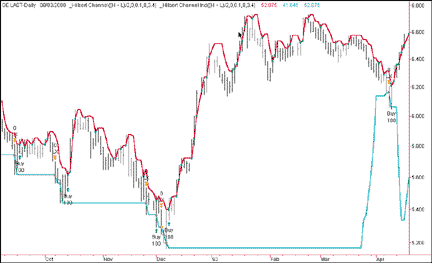Updating A New Classic
Optimizing With Hilbert Indicators
by Roger Darley
Adjusting your trading signals to account for what's actually happening in the market can mean a nice profit for you.
If I knew what the optimum moving average length (or any other filter's length) was on a daily basis, then my indicators and trading strategies could be optimized for what is actually happening in the market. John Ehlers's recent articles in the March and May 2000 issues of Stocks & Commodities concerning adaptive indicators for traders now make it possible to do just that -- optimize trading strategies for what is actually happening in the market on a day-by-day basis. When I do this, I find I have a 10-20% improvement in my results.

FIGURE 1: INDICATOR. The Hilbert channel indicator shows how the adaptive indicator is tracking your trading strategy.
Here's how to build a simple channel breakout system using EasyLanguage code (see Traders' Tips, "Hilbert channel breakout indicator"), which incorporates adaptive filters that adjust moving averages to reflect actual market conditions. I got the idea from working with Ehlers's Mesa software, but the idea works just as well with the indicators that he published in S&C.
As a bonus, I have included a new indicator that shows on a TradeStation screen exactly what the adaptive filter is doing with your trading strategy (Figure 1), and Expert Commentary will explain what is happening as your buy and sell signals are generated (Figure 2). Finally, I will step through the optimization process, which is critical when using adaptive indicators in trading, and show you how to get the best performance out of your system.
ADAPTIVE FILTERS
In the March 2000 STOCKS & COMMODITIES, Ehlers published the EasyLanguage code for the Hilbert cycle period, an indicator that plots the length of the current market cycle. He has since updated the code for the indicator (see Traders' Tips, "Refining the Hilbert indicator"), and I have put the current version into an EasyLanguage function that returns the cycle period that will be used by our signal to generate buy and exit orders. Be sure that the name "HilbertPeriod" is assigned to the function. (See Traders' Tips, "Hilbert cycle period function.")
Excerpted from an article originally published in the November 2000 issue of Technical Analysis of STOCKS & COMMODITIES magazine. All rights reserved. © Copyright 2000, Technical Analysis, Inc.
Return to November 2000 Contents